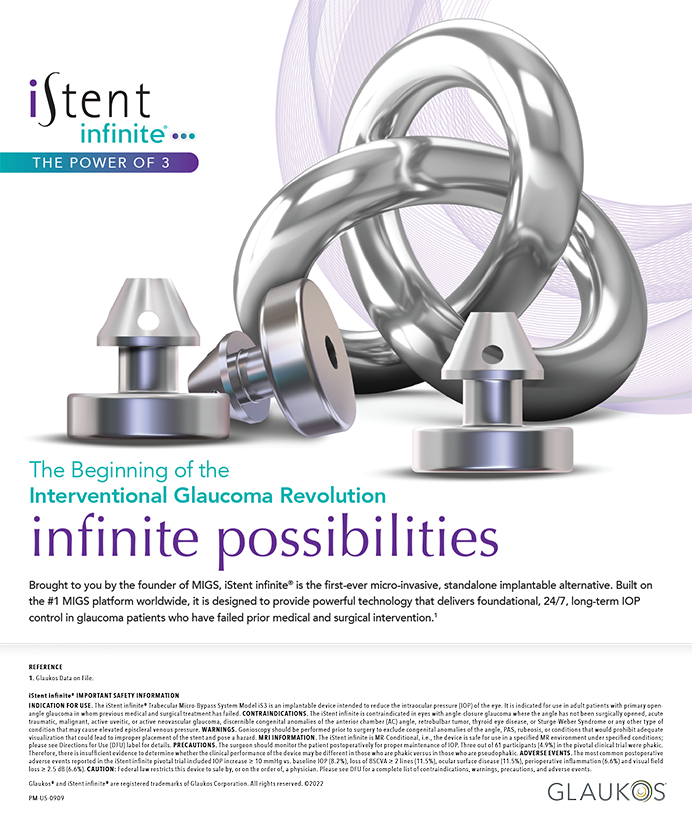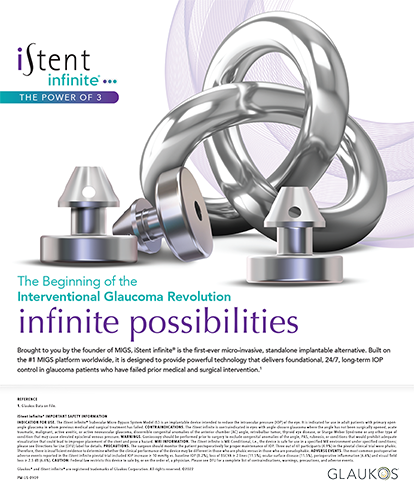The surgeon has determined that a patient has an acceptably good prognosis for a multifocal IOL, including an adequately healthy cornea, macula, and optic nerve. The patient has decided that he or she desires a multifocal lens. A few additional considerations remain in the selection of an IOL.
BODY HABITUS
The focal length of multifocal lenses differs. Among the diffractive models, the Tecnis Multifocal IOL (ZMAOO and ZMBOO; Abbott Medical Optics Inc.) has an add power of +4.00 D. This may be a suitable and even desirable reading distance for a diminutive patient with short arms. A tall patient with long arms, however, can find this working distance uncomfortably close and will likely do better with a +3.00 D add, as is found with the AcrySof IQ Restor IOL +3.0 D (SN6AD1, MN6AD1; Alcon Laboratories, Inc.).
DAILY ACTIVITIES
Some presbyopic patients perform many intermediate-range tasks such as the use of computers and tablets, knitting, and cooking. These individuals are well suited to multifocal lenses with a +3.00 D add; the near point will be closer to their midrange, and thus, the summation that occurs between the two focal points will be higher and, consequently, superior for intermediate tasks than an IOL with a +4.00 D add. Some surgeons advocate using multifocal IOLs with a +4.00 D add for these patients and targeting slight hyperopia to compensate for an undesirably close near point. I strongly discourage this approach and find that patients are happiest with a plano distance result
ENVIRONMENTAL ILLUMINATION
The diffractive steps of the Tecnis Multifocal IOL appear from its center to its periphery, and the steps are of equal height at all loci on the implant. This design distributes more light to the near add relative to the distance focal point compared with an apodized lens like the AcrySof Restor. The latter's diffractive steps decrease in height from the center outward, and they are confined to the central 3.7 mm of the IOL's optic. Accordingly, many surgeons feel that, as a group, patients who receive the Tecnis Multifocal lens perform better at near in dimly lit situations (eg, the candlelit restaurant to which Dr. Katsev alludes) than patients with the AcrySof Restor lens. For the same reason, patients with the Tecnis Multifocal may also tend to notice more halos at night around point sources of light against a dark background (eg, streetlights at night) than individuals with the AcrySof Restor.
PUPILLARY SIZE
The refractive ReZoom IOL (Abbot Medical Optics Inc.) has a large central zone that is distance only. I have seen some patients who have no near or intermediate benefit with this lens when their pupil is at rest but who perform well at near when it is pharmacologically dilated. Obviously, this is an untenable and unhappy result for both the patient and the physician. My colleagues and I rarely use the ReZoom in our practice, because we have found that diffractive multifocal IOLs perform better.
Interestingly, the initial FDA data on the ReZoom demonstrated a similar incidence of halos, by percentages, as for the diffractive multifocal IOLs, yet in my experience, the vehemence of the patients' complaints about this phenomenon was unmistakably greater with the refractive lens. Studies of the clinical incidence of glare with multifocal lenses are difficult to interpret, due to highly inconsistent rates of implantation among the different multifocal lenses. Knowing the rates of unhappy patients with these IOLs in a referral practice is only useful if one also knows the differing frequency of implantation for each style of lens in that community.
LOCATION OF THE IOL
If fixation in the sulcus becomes necessary, the available three-piece multifocal IOLs perform similarly to surgeons' expectations, especially if their optics can be captured in the capsulorhexis and the capsule covers the margin of the IOL's anterior edge (Figure). Surgeons should avoid implanting single-piece PCIOLs in the sulcus, because this placement increases the risk of pigment dispersion or a condition resembling uveitis, glaucoma, hyphema syndrome.1 For passive sulcus fixation in which capture with the capsulorhexis is not possible, a round-edged PCIOL is a better choice, and of course, the IOL's power will need to be reduced relative to that calculated for the lens' placement in the bag.
CONCLUSION
Multifocal IOLs are a wonderful option for presbyopic patients who desire increased independence from spectacles. Surgeons should carefully weigh each option on a patient-by-patient basis in order to recommend the IOL most likely to suit his or her desires, lifestyle, and ocular anatomy.
Michael E. Snyder, MD, is in private practice at the Cincinnati Eye Institute and is a voluntary assistant professor of ophthalmology at the University of Cincinnati. He is a consultant to Alcon Laboratories, Inc. Dr. Snyder may be reached at (513) 984-5133; msnyder@cincinnatieye.com.
- Kohnen T, Kook D. Solving intraocular lens-related pigment dispersion syndrome with repositioning of primary sulcus implanted singlepiece IOL in the capsular bag. J Cataract Refract Surg. 2009;35(8):1459-1463.


